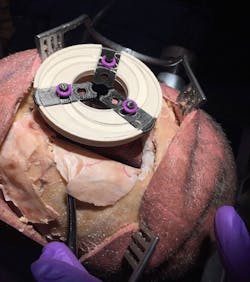Surgical Tool Manipulates Brain to Create Working Space for Doctors
A team of biomedical engineering students at Johns Hopkins University, CortiTech developed Radiex, a brain retractor designed to reduce injuries during brain surgery. Brain retractors are used to mechanically pull back cortical tissue, revealing areas a neurosurgeon might want to operate on. However, the versions currently in use can cause unintentional damage, owing to their inflexibility or the exertion of too much pressure: Injuries such as brain swelling, hemorrhages, and brain infarctions have been reported in 9% of the patients they are used on.
Radiex, by contrast, boasts a rounded design, meaning radial pressure is distributed. Its small point of entry lets it be used in minimally invasive operations, and the point of insertion can be adjusted and expanded mid-procedure—a feature current devices lack. If used, Radiex should decrease recovery times, reduce major complications that endanger patients, and lower the need for post-operative care.
The innovative design, developed by Team CortiTech, is the product of more than a year of brainstorming, prototyping 20 to 30 different designs, testing, and retesting.
During a preliminary cadaver test, Radiex was inserted, toggled, and adjusted by a neurosurgeon to validate its usability in surgery. (Courtesy: Johns Hopkins University)
To develop Radiex, the team consulted with Alan Cohen, a Johns Hopkins professor of neurosurgery, who pushed for the minimally invasive design because of his own experiences in the operating room. They also observed neurosurgeries and were given the opportunity to test their prototype on a cadaver. More recently, the team has been working closely with neurosurgery resident Rajiv Iyer to ensure Radiex’s design is user-friendly as well as functional.
Team members say they hope to get Radiex manufactured and hope to apply for FDA approval by the end of this year.
The team and surgical tool placed first in the Biomedical Engineering Society’s Undergraduate Design Competition and at the design by Biomedical Undergraduate Teams Challenge, sponsored by the National Institutes of Health. The device also earned second place in the Collegiate Inventors Competition. This contest, hosted by the National Inventors Hall of Fame in Washington, D.C., awards students for innovation, potential, and solutions to real-world problems.


